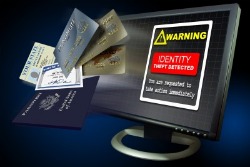Computer Security Threats.
Are You Prepared?
Ignoring Computer Security Threats can cost you big time... and is definitely not a case of "ignorance is bliss".
If you don't know how to protect your computer from threats like the "Love Letter Worm", malicious apps, Trojan Horses, botnets, zombies and all the rest.. then get ready to lose important data, pictures, money, even your identity.
Malware (Malicious Software).
Malware is software designed to secretly gain access to your computer to either damage it, steal confidential data from it, or to hi-jack it to take part in other illegal applications.

Malware attacks in the 1980's and 90's were often carried out by young programmers as pranks rather than with criminal intent.
That has well and truly changed in the last decade. Computer security today is at serious risk of attack from well organized Internet criminals, scammers, politically motivated hackers and terrorists, and cyber predators.
Malware Definitions.
Virus: a parasitic program that spreads when the infected file is opened and attaches copies of itself to other files to possibly damage or delete files, hi-jack a computer, or steal data.
Worms: are programs that replicate themselves through a network often opening a computer's "back door" (a security flaw in software) to allow hacker access. Worms need no human intervention and spread with incredible speed.
Trojan Horses: are malicious payloads concealed in desirable programs that are used to attract users to download them, and which can damage files or later install other harmful spyware or worms.

Over 50% of all spam is sent from computers controlled by Remote Access Trojans. Trojans like Qhost target users accessing banking websites then open a spoofed login page to steal passwords and bank account details.
Phishing: involves malicious websites set up to look like a trustworthy organization (like a bank) in an attempt to trick you into providing credit card details, bank account numbers, etc.
Zombies: are programs implanted in your computer (often by email attachments) that can be activated remotely to use your computer in a massed computer attack on other sites. They don't normally damage the host computer. A Botnet is a network of "zombies" controlled by a "bot" controlled by the malware creator.
Malvertising: is advertising that contains malware. Dasient Web Security research estimates "The probability an average Internet user will hit an infected page after 3 months of Web browsing is 95%".
Spyware (Adware): are programs that secretly monitor the activity on your computer and send that information back to the originator. Spyware doesn't usually refer to undercover spies or operatives but rather the advertising industry trying to determine your online activities or shopping habits (e.g. cookies), trying to direct you to preferred websites, or targeting you with pop-up ads. Spyware programs can also change your browser's homepage, slow down your computer, change toolbars, search engines and icons, and inactivate certain keys (e.g tab key).
Warning: Some more dangerous, invasive versions of spyware can actually track what keys you type by installing a "key logger".

That means some one out there may be able to read everything you type... all your personal details, passwords, confidential business information, even your bank and credit card details.
That leaves you wide open to fraud and theft, having your identity stolen, or even putting the personal safety of you and your family at risk if you don't take computer security threats seriously.
Facts About Computer Security Threats.
- 1988... the first "Internet Worm" released by university student Robert Morris.
- 1999...Melissa virus (named after a lap dancer) shuts down Internet mail systems by clogging them with infected emails.
- 2001... Code Red and Ramen Worms vandalize hundreds of thousands of websites.
- 2004... Cabir, the first mobile phone virus appears.
- 2006... cyber criminals steal and sell over 170 million credit card numbers from large U.S. retailers.

- 2007... F-Secure Internet Security estimates as much malware was produced this year as was
produced in the previous 20 years.
- 2008... the "most advanced" Torpig Trojan steals details of some 500,000 online bank accounts, credit and debit cards.
- 2008... Anti-virus supplier Symantec believes the number of malicious programs being released outnumbers legitimate software.
- March 2010... Shaoxing, China named "Malware Capital of the World" by Symantec Corp.
- 2011... 58 malicious Android apps identified after 260,000 already downloaded.
- 2011...cyber attack on G20 nation France compromises 150 computers and shuts down 10,000 more.
Tip: Always take Computer Security Threats seriously and remember... most systems contain defects or weaknesses just waiting to be exploited by malware.
"The World Wide Web is a criminal's preferred pathway for spreading malware. About one in ten Web pages may contain malicious code"... Wikipedia.
Who Ate My Lunch?
by Eugene Roberts

The Internet Revolution, Globalization, and the Global Financial Crisis created the perfect storm... Old Business models are being destroyed and jobs are disappearing offshore at an astonishing rate. Analysts warn that "China and India are poised to out-think us and out-compete us by their sheer numbers" and that "there is no job security now".
Read more of
Who Ate My Lunch?
for free.






